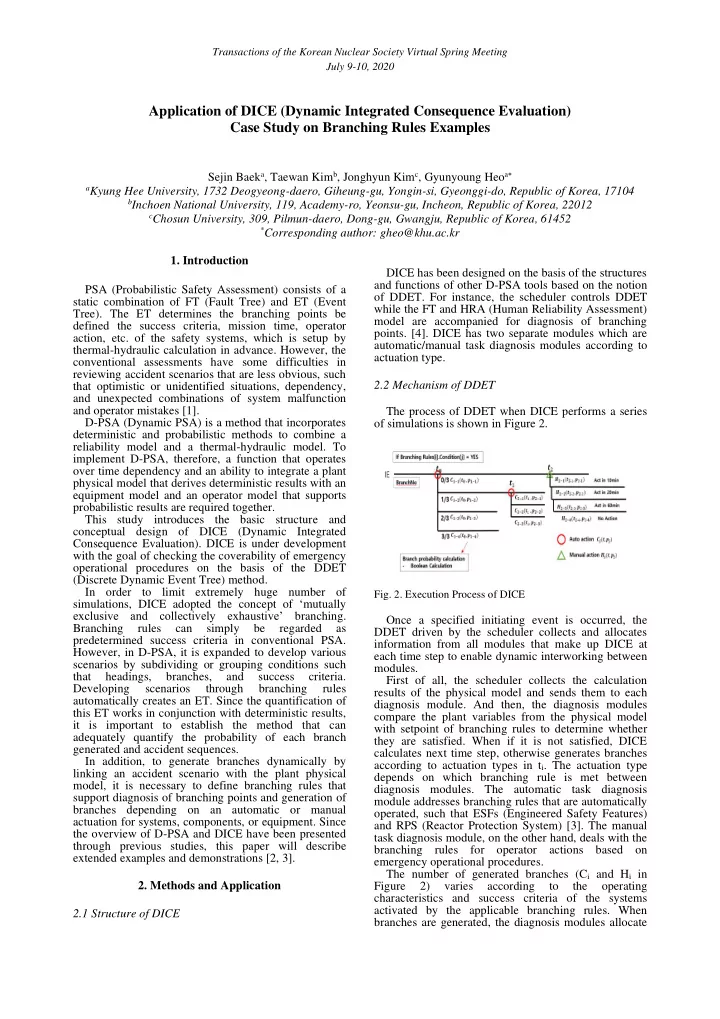

Transactions of the Korean Nuclear Society Virtual Spring Meeting July 9-10, 2020 Application of DICE (Dynamic Integrated Consequence Evaluation) Case Study on Branching Rules Examples Sejin Baek a , Taewan Kim b , Jonghyun Kim c , Gyunyoung Heo a a Kyung Hee University, 1732 Deogyeong-daero, Giheung-gu, Yongin-si, Gyeonggi-do, Republic of Korea, 17104 b Inchoen National University, 119, Academy-ro, Yeonsu-gu, Incheon, Republic of Korea, 22012 c Chosun University, 309, Pilmun-daero, Dong-gu, Gwangju, Republic of Korea, 61452 * Corresponding author: gheo@khu.ac.kr 1. Introduction DICE has been designed on the basis of the structures and functions of other D-PSA tools based on the notion PSA (Probabilistic Safety Assessment) consists of a of DDET. For instance, the scheduler controls DDET static combination of FT (Fault Tree) and ET (Event while the FT and HRA (Human Reliability Assessment) Tree). The ET determines the branching points be model are accompanied for diagnosis of branching defined the success criteria, mission time, operator points. [4]. DICE has two separate modules which are action, etc. of the safety systems, which is setup by automatic/manual task diagnosis modules according to thermal-hydraulic calculation in advance. However, the actuation type. conventional assessments have some difficulties in reviewing accident scenarios that are less obvious, such 2.2 Mechanism of DDET that optimistic or unidentified situations, dependency, and unexpected combinations of system malfunction and operator mistakes [1]. The process of DDET when DICE performs a series D-PSA (Dynamic PSA) is a method that incorporates of simulations is shown in Figure 2. deterministic and probabilistic methods to combine a reliability model and a thermal-hydraulic model. To implement D-PSA, therefore, a function that operates over time dependency and an ability to integrate a plant physical model that derives deterministic results with an equipment model and an operator model that supports probabilistic results are required together. This study introduces the basic structure and conceptual design of DICE (Dynamic Integrated Consequence Evaluation). DICE is under development with the goal of checking the coverability of emergency operational procedures on the basis of the DDET (Discrete Dynamic Event Tree) method. In order to limit extremely huge number of Fig. 2. Execution Process of DICE simulations, DICE adopted the concept of ‘ mutually exclusive and collectively exhaustive’ branching. Once a specified initiating event is occurred, the Branching rules can simply be regarded as DDET driven by the scheduler collects and allocates predetermined success criteria in conventional PSA. information from all modules that make up DICE at However, in D-PSA, it is expanded to develop various each time step to enable dynamic interworking between scenarios by subdividing or grouping conditions such modules. that headings, branches, and success criteria. First of all, the scheduler collects the calculation Developing scenarios through branching rules results of the physical model and sends them to each automatically creates an ET. Since the quantification of diagnosis module. And then, the diagnosis modules this ET works in conjunction with deterministic results, compare the plant variables from the physical model it is important to establish the method that can with setpoint of branching rules to determine whether adequately quantify the probability of each branch they are satisfied. When if it is not satisfied, DICE generated and accident sequences. calculates next time step, otherwise generates branches In addition, to generate branches dynamically by according to actuation types in t i . The actuation type linking an accident scenario with the plant physical depends on which branching rule is met between model, it is necessary to define branching rules that diagnosis modules. The automatic task diagnosis support diagnosis of branching points and generation of module addresses branching rules that are automatically branches depending on an automatic or manual operated, such that ESFs (Engineered Safety Features) actuation for systems, components, or equipment. Since and RPS (Reactor Protection System) [3]. The manual the overview of D-PSA and DICE have been presented task diagnosis module, on the other hand, deals with the through previous studies, this paper will describe branching rules for operator actions based on extended examples and demonstrations [2, 3]. emergency operational procedures. The number of generated branches (C i and H i in 2. Methods and Application Figure 2) varies according to the operating characteristics and success criteria of the systems activated by the applicable branching rules. When 2.1 Structure of DICE branches are generated, the diagnosis modules allocate
Recommend
More recommend